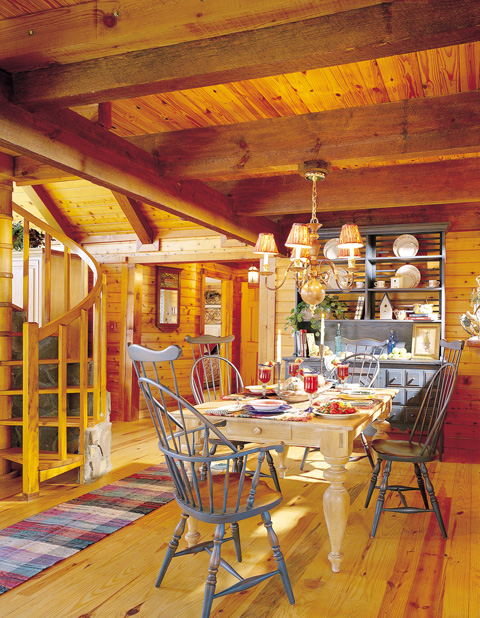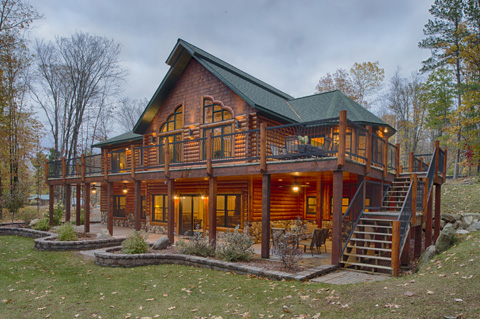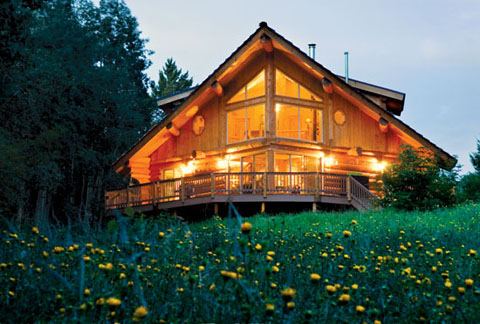Choosing a stain, paint, or sealant for your log home may be as challenging as finding the perfect lot or settling on a specific floorplan. The choices abound, and the uses are often confusing. But there is hope in having an easier time making the right decisions. Before committing to a stain, sealant, or paint, understanding the attributes of each is a prerequisite. Knowledge of the basics makes charting the course easier.
“On log homes the stain performs two basic jobs, protection of the structure and aesthetic appeal to the owner,” explains Tony Huddleston, vice president of sales and operations at Permachink. As far as paint, it is often used to hide something such as unstable wood. We feel that logs should not be painted, as some paints will not breathe to allow moisture to escape, and over time that can cause problems. Sealants are used to seal areas that need to be closed tightly to prevent any water infiltration, air infiltration, and of course, insect infestations.”
Applying stain to an exterior is pretty much essential for several reasons: moisture resistance, air filtration, pest deterrence, and UV damage. “Here at Sashco, we like to call UV damage the ‘gateway drug’ to the other three,” smiles associate brand manager Charis Babcock. “When the surface is unprotected against UV damage, all of the other three can easily make their way in. So many stains either soak in too deeply and leave the surface unprotected, or they aren’t elastic enough to handle the movement that logs undergo.”
For exterior stains, the two primary properties are UV resistance and elasticity. “So, if you are looking for durability,” advises Babcock, “use a stain that is specifically made for log homes. That’s usually a sign of higher quality pigments and at least a little elasticity. There are water-based, oil-based, and hybrid stains that fit this bill.”

Original Log Cabin Homes
Interior staining presents another issue. Is it worthwhile? “It’s always a good idea to get a good inside finish,” relates Barbara Murray, owner of CTA Products Group, “or one day the inside of the home may begin to take on fireplace and cooking odors, and the logs will get dusty and become harder to clean.”
Finding an appropriate sealant requires a bit of clarification. According to John Schroeder of Schroeder Log Supply, the term is frequently used to describe two things. “A sealant may be defined as the top clear coat that goes over the stain,” he says, “and these are required for some but not all stain systems. They are generally not used over paint because paint shouldn’t be used on logs. Sealant is also defined as a caulk or chinking used to provide airtight and watertight seals in cracks and gaps in the home. Compatibility can be a concern, especially when using a water-based caulk with an oil-based stain.”
Both Schroeder and Murray advise checking with the log home dealer before proceeding and perhaps doing a small test area to gauge the results before moving ahead with the entire home. Compatibility is crucial.
Paint most often finds its way onto a log home exterior for aesthetic reasons, says Huddleston. “It’s commonly incorporated in trim or soffits to either blend or contrast with the roof colors or accent designs.”
Some advisers discourage the application of exterior paint while citing issues with trapping moisture. Babcock comments, “Paint is a bad idea on logs for two reasons. It’s too thick, and therefore easily traps moisture, and when moisture is trapped any developing problems are hidden. I’ve seen pictures of homes where entire corners have been rotted out and the homeowner never knew because the paint was hiding the problem. These situations can be very expensive to repair. For the exterior, use paint as an accent on trim and doors, but stick with a semi-transparent stain on the exterior log walls themselves.”
Paint does sometimes have its place in the log home interior. “It should generally be reserved for trim and accents,” relates Schroeder. Babcock adds, “On a log home interior, different paint colors can be great accents, especially if there are any areas that have drywall. A bright yellow against mahogany floors or a deep hunter green on the cabinets next to natural log walls can create quite a scene. Painting logs on the interior isn’t as big a deal as it is on the exterior, but it’s still not the best idea. But you certainly have more freedom.”
Once a log home is complete, the focus shifts to the ongoing task of maintenance. While no home is hassle free, the use of quality products prolongs the life of any protective material. Still, the need to restain and reseal will emerge sometime in the future.
“Conceivably, if a home were built with a design that protects it perfectly from the elements—if the first course of logs were at least two feet above ground, and if the eaves were long enough to keep the logs perfectly dry—it would be possible for a log structure to last indefinitely without a coating,” Schroeder offers. “Given the design of most buildings, however, a quality finish is required to keep the logs water repellent, UV resistant, and capable of combating the natural effects of nature.”
“For a log home interior,” he concludes, “stains and sealants aren’t necessary. However, at a minimum a clear finish is recommended to keep the interior logs easy to clean and for better luster and appearance. A breathable finish is highly recommended in high moisture situations like bathrooms.”
Compare, seek advice, and determine what works best for your log home. Consider climate, quality, and cost in the continuing effort to maintain beauty and value.


